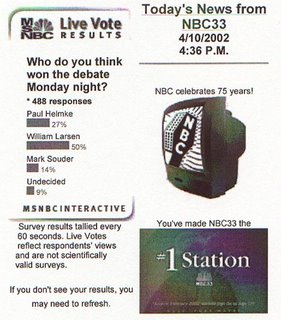Disabled Veterans Milage Reimbursement
Mark Souder proposes to reimburse Veterans for milage over 30 miles. His premise is that government workers get 50.5 cents per mile when they drive on government business. Those who serve should have the same benefit as government workers. Currently only those with a 30% rating or higher and meet an income requirement may be reimbursed.
As a service connected disabled veteran who has traveled twice to Marion’s VA hospital for treatment, I know the cost is high. It took me over an hour and a half to drive the 62 miles one way. Each time the VA staff sent me right back to Fort Wayne for tests that had to be done before they could do anything. Five minutes later I was in my car traveling back to Fort Wayne. I had wasted three hours of my time, consumed four gallons of gas, polluted the air, and still had not received the necessary treatment I needed. I can sympathize with my fellow veterans. However, my question is why should government workers get 50.5 cents per mile? When employees travel on company business, most companies specify a compact rental. Why should government employees be any different? What standard should we use full size sedan or compact?
Let us look at the cost of operating a motor vehicle. Gas at $4.10 a gallon is a large cost, but it is not the only cost. If the 50.5 cents a mile were simply to reimburse for gas, then we are looking at a gas milage of only 8.1 mpg. This is terrible milage! Therefore, the government, we the taxpayers, should demand and require those government employees who drive cars, use cars that get at least 30 mpg. This puts the gas cost at 13.7 cents per mile. Therefore, instead of raising veterans to 50.5 cents a mile, we should reduce government reimbursement to 13.7 cents per mile.
Ok, this does not reimburse the government employee for oil changes, tires, windshield wiper blades, etc. So let us figure out what these cost. Tires at $375, wiper blades at $25 and oil change at $21.95 increases milage costs by 1.3 cents. Therefore, we reduce it from 50.5 cents to 15 cents. Ok, this does not compensate for the capital cost of the car. Capital costs come in at about 8 to 10 cents per mile so we increase the reimbursement to 25 cents per mile. Repair costs might be a large factor. Most warranties are for 100,000 miles. Clearly, if the warranty and maintenance costs exceed 8 to 10 cents per mile, it is cheaper to replace the car therefore; it is safe to assume that these costs are less than 10 cents per mile. Add 10 cents per mile and we are at a reimbursement rate of 35 cents per mile.
Instead of adding a new benefit and brining that benefit up to the level of government employees, maybe we should reduce the government benefit and add the veterans benefit with a net savings to the taxpayer. This is the problem with politicians. They see nothing wrong with 50.5 cents per mile. They want to make sure veterans have as good a benefit as they do, at your expense. I will be as frugal with your money as I am with my own!
Sincerely,
William Larsen
Candidate for Indiana’s 3rd district
US Representative



0 Comments:
Post a Comment
<< Home